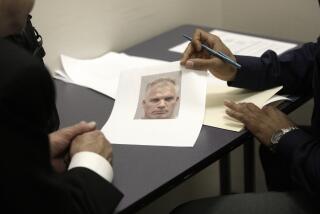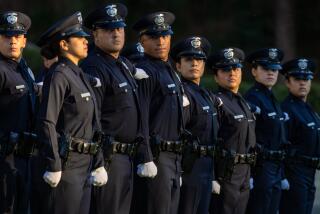CITYSCAPES MILES CORWIN : A New School of Thought for Private Eyes--Cry or Run
Mark Laikind has never fired a gun during his 17 years as a private investigator. He has never even fired his tear gas canister, which he packs every day in a tiny leather holster clipped to his belt.
Laikind shatters one private-eye myth after another while teaching at the Nick Harris Detective Academy in Van Nuys. Students at the school, who are enthralled with the macho image of the detective, are routinely put off by two techniques that Laikind uses while on a stakeout--crying and running.
A detective trying to stay anonymous often can drive off a bystander who peppers him with questions, Laikind told the students, by bursting into tears and babbling about a recently lost love. “And if things get dire and you’re really threatened by someone,” he told them, “I believe in running away.”
The academy--founded in 1907 and one of only a handful of private detective schools in the country--offers an 11-week course that Laikind claims is equivalent to four years of on-the-job training. Student Kathy Hutcherson, a chain-smoking former bar owner, became interested in the profession after she retained a detective to follow two of her six ex-husbands.
“I first hired a private eye to tail my second husband . . . I think that was my second husband,” she said, pausing and racking her memory for the correct husband. “Yes, it was my second husband. It was amazing what the private eye found. . . . He really nailed my husband . . . to the wall.”
Another student, a retired fire captain, became intrigued by the work after he hired a private detective to find his brother, who had been missing for 20 years. Other students, like the Iranian insurance salesman and the corporate tax accountant, were looking for adventure.
Unlike the modern-day shamus, Los Angeles’ most famous private eye--Phillip Marlowe--picked up the business on the streets, according to his creator, Raymond Chandler.
Marlowe did have a few years of college in Oregon, but that did not help him much when he decided to become a private detective. So Marlowe moved to Los Angeles and began learning the trade as an investigator for an insurance company and later with the district attorney’s office.
But the D.A. fired him because “he got a little too efficient at a time and in a place where efficiency was the last thing desired by the persons in charge.” Marlowe eventually opened his own private detective firm on the sixth floor of a shabby Hollywood office building.
While Marlowe spent most of his days prowling the streets of a city he described as “lost and beaten and full of emptiness,” the 15 students at the Nick Harris Detective Academy rarely leave the classroom. They listen to lectures, scrawl notes, peruse law and code books and take tests.
During a recent class, Laikind, who wears a sport coat and slacks and has a ponytail that reaches the middle of his back, spent almost the entire day pacing the classroom and discussing “rolling surveillance”--the tailing of a subject by car. Car chases are fine for the movies, Laikind told the students, but real private eyes cannot run red lights and make fishtail U-turns because they have to worry about traffic tickets and rising insurance premiums.
Parking tickets also are something that television private eyes do not have to concern themselves with. Laikind emphasized the importance of never going out on assignment without a pocketful of change.
Much of the class was devoted to unglamorous, but practical, surveillance techniques that most private eyes learn on the job. A few surveillance essentials that Laikind discussed were inside details, matters too delicate to portray on shows such as “Magnum, P.I.” Laikind told the students about devices, sold at medical supply stores, that are essential for agents on stakeouts who drink a lot of coffee but cannot leave their cars.
Laikind eventually discussed more dramatic techniques to evade detection such as: RUR--right turn, U-turn, right turn; and yo-yoing--driving past a subject then tailing behind. And he told them to leave the flashy Italian sports cars to the movies. He suggested that they buy economy cars in earth-tone colors.
In addition to surveillance, the would-be detectives, who pay about $4,000 in tuition, study the basics of wiretap detection, missing person traces, fingerprinting, criminal investigation and undercover work. The top students are hired by the Nick Harris Detective Agency, Laikind said, and the vast majority of the others find work at other agencies, where they have to work for three years before they can apply for a state license.
But, Laikind told the students, no matter what jobs they find, whether it is glamorous counterespionage work or lowly foot surveillance, they should never forget one thing:
“Always save your receipts.”
More to Read
Sign up for Essential California
The most important California stories and recommendations in your inbox every morning.
You may occasionally receive promotional content from the Los Angeles Times.










